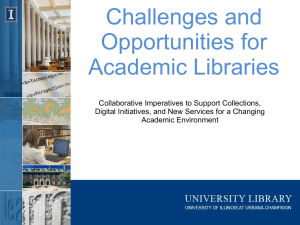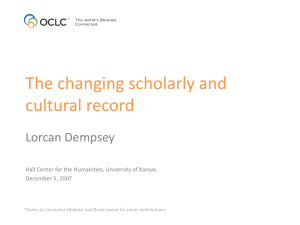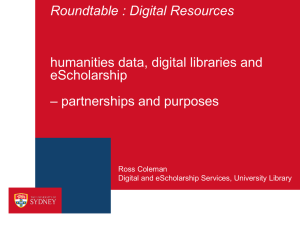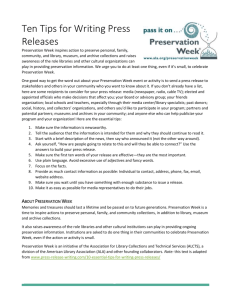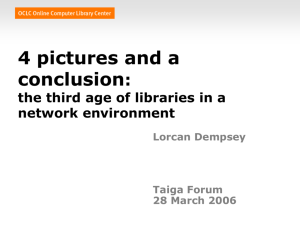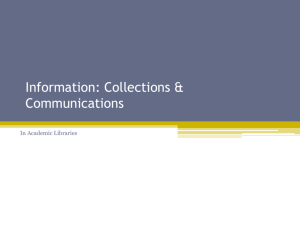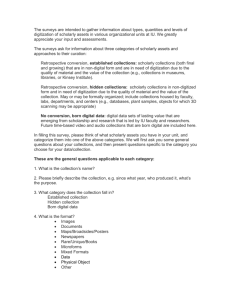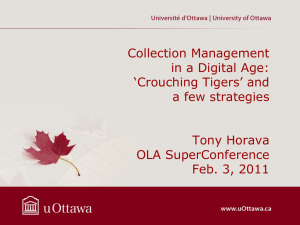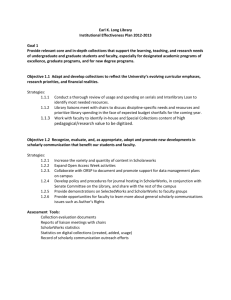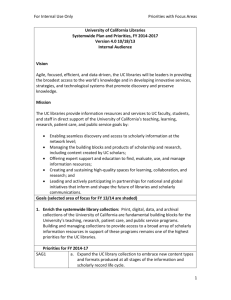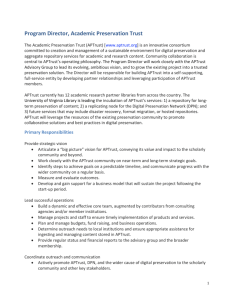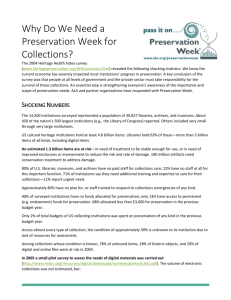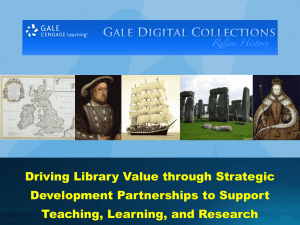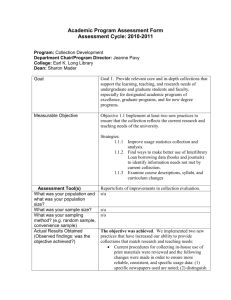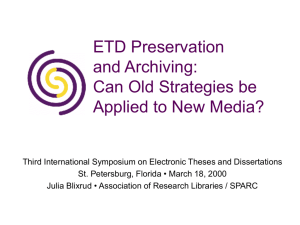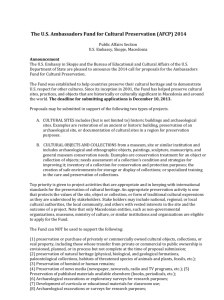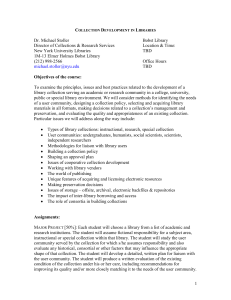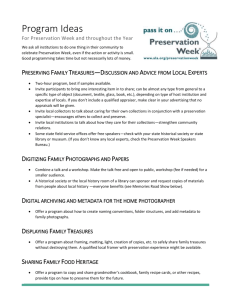Generic Statement of Professional Duties and Responsibilities
advertisement
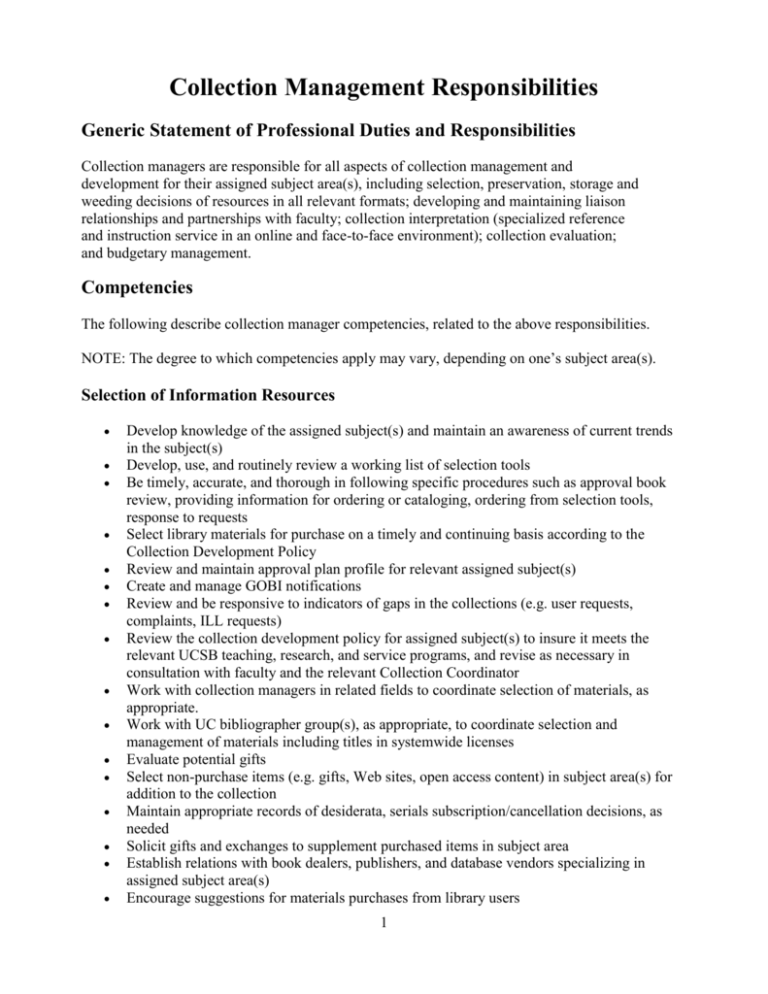
Collection Management Responsibilities Generic Statement of Professional Duties and Responsibilities Collection managers are responsible for all aspects of collection management and development for their assigned subject area(s), including selection, preservation, storage and weeding decisions of resources in all relevant formats; developing and maintaining liaison relationships and partnerships with faculty; collection interpretation (specialized reference and instruction service in an online and face-to-face environment); collection evaluation; and budgetary management. Competencies The following describe collection manager competencies, related to the above responsibilities. NOTE: The degree to which competencies apply may vary, depending on one’s subject area(s). Selection of Information Resources Develop knowledge of the assigned subject(s) and maintain an awareness of current trends in the subject(s) Develop, use, and routinely review a working list of selection tools Be timely, accurate, and thorough in following specific procedures such as approval book review, providing information for ordering or cataloging, ordering from selection tools, response to requests Select library materials for purchase on a timely and continuing basis according to the Collection Development Policy Review and maintain approval plan profile for relevant assigned subject(s) Create and manage GOBI notifications Review and be responsive to indicators of gaps in the collections (e.g. user requests, complaints, ILL requests) Review the collection development policy for assigned subject(s) to insure it meets the relevant UCSB teaching, research, and service programs, and revise as necessary in consultation with faculty and the relevant Collection Coordinator Work with collection managers in related fields to coordinate selection of materials, as appropriate. Work with UC bibliographer group(s), as appropriate, to coordinate selection and management of materials including titles in systemwide licenses Evaluate potential gifts Select non-purchase items (e.g. gifts, Web sites, open access content) in subject area(s) for addition to the collection Maintain appropriate records of desiderata, serials subscription/cancellation decisions, as needed Solicit gifts and exchanges to supplement purchased items in subject area Establish relations with book dealers, publishers, and database vendors specializing in assigned subject area(s) Encourage suggestions for materials purchases from library users 1 Collection Management: Storage, Preservation and Weeding Maintain awareness of the collaborative infrastructures for long-term preservation of collections (e.g., HathiTrust, Western Regional Storage Trust, Portico) Designate appropriate processing priorities Review current serial subscriptions for appropriate action Consult with appropriate departments on cataloging and binding problems Monitor use in order to identify needed additional copies, replacement copies, or subsequent editions Identify deteriorating library materials that should be preserved Evaluate materials for limited access because their condition, value, or demand requires special protection Negotiate needed transfers from one location to another Select lesser-used materials for location in SRLF, the Annex, or withdrawal Faculty Liaison Activities Establish and maintain good communication with the academic department's library liaison Visit the department chair on a regular basis to discuss the department's plans, including the recruitment of new faculty and the development of new courses Visit each member of the faculty at least annually to discuss his/her library needs. Become familiar with the research interests, professional activities, and related technological needs (e.g., digital content preservation and management) of each faculty member Contact each new faculty member and offer to provide a special orientation to the library's resources and services Become familiar with issues around management of intellectual property (e.g., Merritt for preserving and managing digital content, UC eScholarship’s publishing and repository services) Become knowledgeable about the composition of the academic department, including number of full-time faculty, lecturers, majors, teaching and research assistants, graduate students, etc. Keep informed about the curriculum and any curricular changes Offer to attend faculty meetings to update the department on library issues Develop communication mechanisms for informing the department about library resources and services Consult with appropriate faculty before acquiring expensive items or changing collecting policies Offer to work with the faculty to develop library instruction for classes with research needs Provide research consultation for faculty and students as appropriate (e.g., via email, faceto-face, during departmental office hours) 2 Collection Interpretation Direct User Instruction: Provide general and specific assistance to users in selecting and locating appropriate materials for their research. Types of general assistance: 1. 2. 3. 4. Provide general reference service Conduct general orientation tours Offer general workshops in new sources, especially new technologies Participate in library instruction program Types of specific assistance: 5. Establish with graduate advisors a system of notifying each graduate student of library services (e.g. research consultations, online searches, etc.) 6. Offer faculty course-related lectures Indirect User Instruction: Encourage user interest in and understanding of library resources and services by actively undertaking the following: 1. Create and maintain LibGuides for general reference and course-integrated instruction 2. Offer staff training/workshops on new resources 3. Maintain ongoing awareness of new resources for referrals, including those in regional libraries and open access resources Collection Evaluation Know the strengths and weaknesses of the assigned subject collection(s) Conduct an evaluation of discrete parts of the assigned subject collection(s) each year Undertake major assessments of significant portions of the assigned subject collection(s) every 3-5 years Budgetary Management Manage all funds for assigned area Stay abreast of the current trends in discipline-related costs for different types of materials (books, periodicals, software, etc.) and formats (print, electronic, media, microform, etc.) Stay abreast of the current trends in exchange rates and other costs associated with acquiring materials Develop written justifications for funding special needs Establish and apply priorities for spending allocated funds Monitor spending and adjust spending as needed 3 Resource Sharing Develop knowledge of existing resource sharing agreements and their impact on selection decisions Consider potential resource sharing agreements and their impact on the collection development policy Coordinate selection policies with other collection managers, libraries, and UC bibliographer groups Recommend materials for Shared Purchase Program Review Shared Purchase Program proposals and recommend action Explore resource sharing possibilities with other collection managers, libraries (e.g., Center for Research Libraries), and UC bibliographer groups Scholarly Communication Familiarize yourself with and maintain awareness of the following: the various lifecycles of scholarly publishing in assigned subject area(s), from creation to dissemination and use, including author rights, copyright and other intellectual property issues the basics of digital curation and preservation services in support of the intellectual content production activities on campus systemwide policies and initiatives related to scholarly communication [e.g., of the Systemwide Library and Scholarly Information Advisory Committee (SLASIAC) and the University Committee on Library and Scholarly Communication (UCOLASC)] the collaborative infrastructures for the long-term preservation of collections (e.g., HathiTrust, Western Regional Storage Trust, Portico) the common situations where scholarly communication issues can be raised and related services can be promoted UC3’s (UC Curation Center) Web Archiving Service for acquiring, disseminating and preserving Web content the information production and consumption habits of faculty members in assigned subject area(s), including Web 2.0 applications (e.g., Dedoose, blogs, social networks) the issues around management of intellectual property (e.g., Merritt for preserving and managing digital content, UC eScholarship’s publishing and repository services) new open access publications (especially UCSB’s), collections, mandates, and repositories related to assigned subject area(s) open access activities and positions of societies and associations related to assigned subject area(s) Updated 2/22/12 Sherri L. Barnes Updated 6/17/04 Lucia Snowhill L:\collections\collmanduties02-22-12.doc 4
